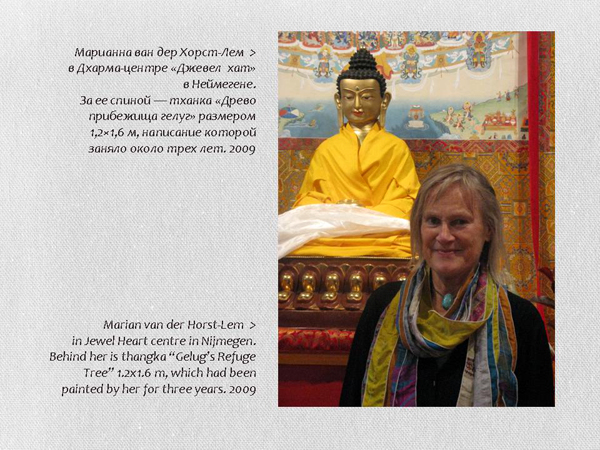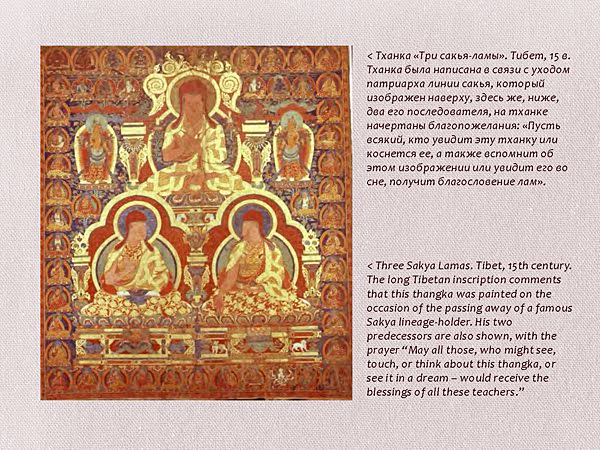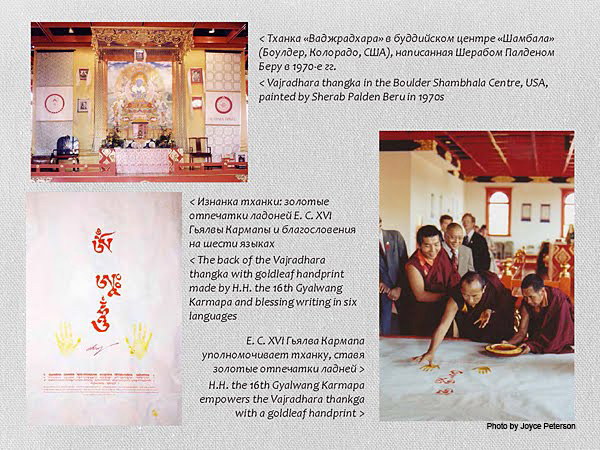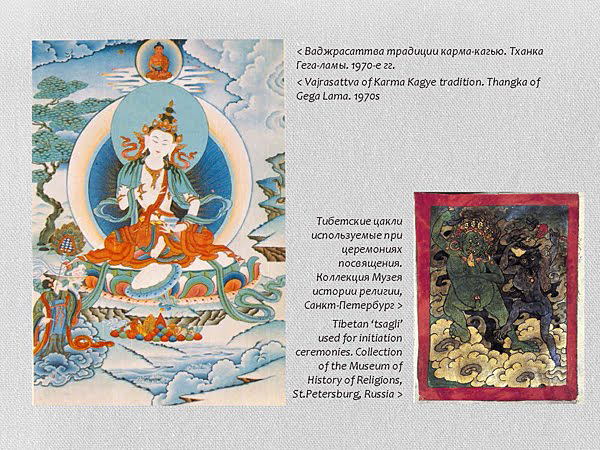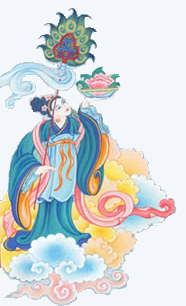
|
|
| gardri @ mail.ru |
| GARDRI — 25 years in Russia |
|
|
| Students |
|
I. For
my students (from Marian’s lections) |
|
For more than twenty last years while the thangka-painting retreats have been happened in Russia Marian van der Horst-Lem trained about 1,000 students. Few of them have become true masters, but the most of students were engaged only in one or two courses. Nevertheless all who studied under Marian's guidance gratefully remember her and note these courses as more meaningful than everyone can assume before. Marian said, "If a man paints the Buddha-this is miracle. It's really pointless to have such target as become the artist of thangka-painting. This can happen, but cannot. It is fine if you paint only a head of Buddha. It is equal fine if you will paint one thangka as well as twenty thangkas."
From the lectures given by Marian van der Horst-Lem
Marian said us that during two years she studied thangka-painting under the guidance of Andy Weber, thangka-painter from England. As Marian remembered, when the courses were over and she staid alone, there appeared many problems, "Sometimes I was really need the teacher's advice." "Thangka-painting is the practice that changes the person. I notice this by my own experience. At the beginning I was a poor student and hadn't enough patience. However don't worry about mistakes that you done, this is really nothing, greatly important only one-to correct them and do not occur in the future. Probably I can teach you because I come through all these problems by myself..." Marian said also that in her teaching she is guided by Gega Lama's example. "The morning began with meditation and then he inspected our works. He spoke very gently, 'This could be a little bit better.' He never looked down on his students and didn't condemn even the apparent failure. From time to time he would to admire looking for a well done image. Once he examined my drawing for very long time and meanwhile I thought about my mistakes Teacher said me, 'This is the best you have ever done,' and I saw tears in his eyes."
The occasion of painting the thangkas When you are just starting to paint the main reason is because you like to do this. In further under professional approach your can receive orders. There is a great difference between secular and thangka painters. Normal artist tries to convey their thoughts, emotions, political views etc. Thangka-painting artists are not involved so much into own feeling. Their visual aids are to be the guide of Buddha and Dharma. They are the servants of Dharma and Sangha. Thus, the purpose of the thangka-painting is helping in understanding of Teaching. That is why the thangka-painting has significant difference from the mundane painting. The more high level of understanding the painter reaches, the more information onlooker gets. Traditionally in Tibet thangkas used in contemplation, Tantric practices, rituals, certain holidays or ceremonies, offerings and gifts. When member of family is ill, dying or experiencing any problems relatives ordered the thangka as a rule. Few ages are known as unfavorable (e.g. 13, 25, 37, 49 years) and Tibetans often order the thangka considering this giving merits the bough-the customer as well as the artist.
Persons who happen to be thangka-painters • The thangka-painter is not certainly Buddhist, but the person who just wields a skilful technique, i.e. craftsman. For example in Nepal many thangkas goes on sale. However much better if the artist is a follower of Dharma. Especially when you paint a deity of Higher Tantra you need to have dedication. • Conventional artists. They can paint the thangka for the ritual or a single case not being practitioners. • People with sensitive perception, clairvoyant. They are able to see the divine image and capture it or give a description that an artist could draw. • Advanced practice. Yogi. • Living beings attained a high spiritual realization. Thus as a rule the karmapas have been gifted in all arts.
In the East artists of thangka-painting often come from artistic families through a long way of learning. The artist considered the completed-'the painter in his own rights' when he knows the proportions and is able to make free-hand drawings of beautiful outlines and gold ornaments. In Tibet the artists were considered mainly as craftsmen although they had devotions and spiritual ambitions. Really the artist of thangka-painting should be modest, religious and not very young as too old. He should be healthy and have a good balanced temper.
How to deal with Buddha's images Every Buddha's image, even done in pencil or ink, is a form of Nirmanakaya (body) of Buddha. Even if the picture is imperfect, it should be treated with great respect. Our schemes that copied from the book of Gega Lama, must be protected as the real thangkas (store it in a clean place or on the altar, don't leave where hit) and not shown persons who don't respect this sphere. Let's try to avoid the situation when your drawing or thangka remain uncompleted for a long time. It is better to burn them out. The more beauty image you have done the more energy of deities it received but even on technically unsuccessful images this effect appears. There are some rules of usage of damaged thankgas. In some cases it can be restored, otherwise it should be burned in a clean place.
Thangka-painting and Dharma The process of thangka-painting is the practice of Dharma. The image on a canvas is a manifestation of the Buddha's body. Trying to create the perfect thangka the artist must have perfect knowledge, therefore the artist relies practice through the activity, speech, meditation, dance etc. We must be careful and concentrated; we should purify our body, speech and mind. It is not only the technique because the images created by us are indeed present here. If the concentration is not perfect we make mistakes. Upon completion of thangka the result already present and it does not matter how long thangka exists. Its influence is important. Thus in a case of sand mandala this longing for several days until the ritual lasts. At every case this is the appearance of new reality. The process of thangka-painting is proposed the artist's preparation. Before the painting he (she) should perform the ritual, read corresponding texts, make offerings, give alms etc. It needs the blessing of the Teacher on painting, tools and materials. The teacher gives the blessing after a meditation on the enlightened beings, asks the deity to enter and sanctify the body, speech and mind of the artist. When the artist should draw idam it is very important to have a dedication to the deity, especially if this is the Tantric form. If he (she) does not have the dedication then through the blessing of the Teacher it's possible to join the mandala of the deity. If an image is related to Annutarayoga Tantra the artist surely must have the dedication to this class of Tantra and practice corresponding mantra. It's desirable to perform the retreat before. Also in obtaining the good result it's important to have a harmonious relationship with the customer. The position of an artist is also important. Right directions are following: face to the East (peaceful deities), South (the deities of wealth, long life), West (Tantric, hemi-wrathful deities) or North (wrathful deities). If you are not able to sit turned in the right direction you should imagine the right position. It's important to observe cleanliness of the workplace, body, speech and mind. Artist should avoid wine and sexual contacts, some kinds of food (onions, garlic), i.e. observe the precepts of Kriya Tantra. The thangka should be free from defects, deficiencies and selfish intentions (for ex. the desire to become famous or rich). Artist relies perceive life with joy, be free from desires and demands during the process of thangka-painting. Traditionally in the East the employer gives an advance payment the artist, meaning that he could lives, works and feeds his family. Gega Lama said me, "You have an education, you artist in your own right and can receive the thangka-painting orders and borrow money for work. But every artist should know how much the customer can pay." On the first steps I advise you not to rush and focus on your pace. This is also a kind of meditation. My Teacher always said that first of all you will need to get used to these measurements. My experience also shows that it is important to learn the proportions and feel the beauty of the figures. Then further, usually one year later, you can begin to paint by colours. You can try to paint earlier of course… |
|
|
|
II. The thangka-painting artist's features
First of all, there are some aspects of the nature of an artist that can be advantages or disadvantages. An example the defect is to engage the arts, whether for their own or someone else's benefit, arrogantly consider himself an artist, even being ignorant in drawing, proportions and the canonical descriptions of the deities depicted. Also is it is very reprehensibly to deceive others by kinds of puzzling hyperboles which are contrary to the spirit of traditional scriptures and the wisdom of the lineage, to provide as reliable all that has no foundation in the art of religious tradition both ancient and modern, to make judgments about thangkas having no knowledge on their origin or qualification of the artist. Also, the artist cannot be at odds with supporters or use a good relationship with them for personal profit. Any of the following characteristics is considered to be flawed in the nature of the artist: grumble, to covet the wealth of others, to demand pay or pay exorbitant prices, to indulge the insatiable greed, to eat unhallowed food as alcohol or meat, to be hypersensitive and to require special attention to the conditions of the work or to work hastily and carelessly, to fall rapidly into anger at the slightest provocation or to be a prattler or ignoramus. You need to have respect for the gods depicted and not treat them carelessly and scornfully, not be sloppy, ignoring the correction of errors or omissions knowing them, as well as negligence allowing the thangkas to be used elsewhere as a result of a lack of distinction of the substantive essence of higher and lower Tantra. Even someone who is an artist only by name must avoid at all such deficiencies. The artist with such flaws in his character can not develop their creative talents. As argued in "The interviews requested by Paldzhor Gyatso" (d.pal.'byor.rgya.mtshos.zhus.pa'i.mdo), "Ignoramuses and prattlers turn good steps in the wrong that is why artist avoids such perverse personalities." With regard to the best qualities of the artist, he have to be skilled in painting, he must know right proportions to maintain the legacy of the art and technique transmission lineage, the difference between a superior and inferior Tantra and understand the distinctive characteristics of peace and angry deities, to paint with devotion elements of composition such as the ornaments, gestures etc. according to appropriate canonical descriptions. The artist must have a propensity to self-restrains, to respect the deity drawn, to be compassionate and patient facing with harsh working conditions or criticism, be skilful in the art and have no vanity about skill, be free from anger and suspicion and not look at the wealth and property of others. He must follow the instructions of their patron without deceit. Depicting the form having no passions (the Buddha) or deities outside Tantra the artist must wash regularly and to be scrupulous in the conduit for what he is observing the requirements of regulations. It is assumed that if he is not a monk, he should maintain precepts during the process of painting of deities of Tantra and meditate continuously. Before the beginning he must hold a ritual to remove potential obstacles introducing himself to meditation as a form of appropriate protective deity the artist cleans the canvas. After that he visualizes himself in the forms of the five Buddha families and sanctifies pigments and brushes in a separate ceremony. Then the artist should be able to draw gold seed syllable of the deity in the centre of thangka surrounded by a mantra as explained in the appropriate Tantra. Until the thangka is not completed he must be able to give power permanently without delay. When the thangka is completed the artist must know how to explain its qualities in order to bring happiness to customer and dedicate merits for the benefit of all living beings in spirit of celebration. These talented artists have been described in verses Selgyal (gsal.rgyal.gyi.tshigs.su.brad.pa, Kandzhur, sutra, f. 201):
Whoever painted the form of the Victorious
Whoever used or painted form of the Sugata,
Whoever used or painted form of the Defender of Universe, |
|
|
|
III. What is religious art are
needed for in Buddhism? Buddhist
art has defined functions. 2. In the second place Buddhist art is believed to be able to transmit blessings or the inspiration of great masters.
3. In the third place art is also used to facilitate meditation and different ritual practices. The Buddha image, for example, serves as a base for śamatha meditation, and different Tantric images are needed for certain initiation ceremonies, etc.
4. Fourthly, Buddhist images are created and worshipped for collecting merit.
It is believed that in addition to the accumulation of wisdom is very important to accumulate merits. This is achieved by the sometimes very simple actions: prostrations, the manufacture of ritual items and sacred images, such as clay tsa-tsa, sculptured or painted images. |
|
15.09.2019 |
